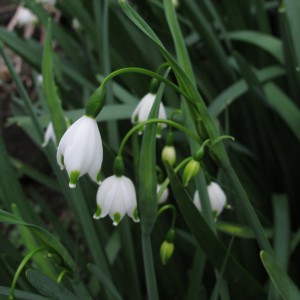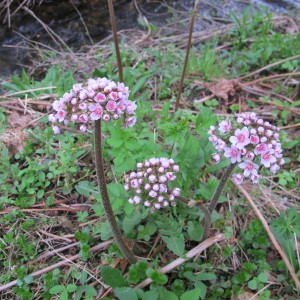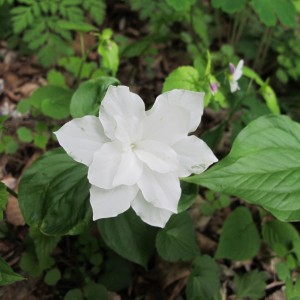Spring Flowers
Each year I anticipate spring with great enthusiasm not because I don’t like winter – which I do – but because almost every day there are new flowers blooming in my garden. I’m keeping a list as they bloom this year, and so far, near the end of May, I have almost 50 species and countless varieties that either have bloomed, or are blooming in my garden.
First to bloom each spring are the small bulb plants: snowdrops, winter aconite, scilla and glory of the snow. Then come the daffodils and tulips – many of which are still blooming nicely. My late tulips are still in bud.
This year I have some lovely grape hyacinths (Muscari spp.) including one called ‘Christmas Pearl” that I got from Brent and Becky’s bulbs last fall. I especially like it because each little bulb seems to send up 2 blossom stems, one large blossom and then a second smaller blossom a while later.
Now I have spring snowflake (Leucojum vernum) in bloom.Or maybe it is summer snowflake (L. aestivum). They both look a bit like snowdrops on steroids. The white blossoms look down like snowdrops, but are atop 16 inch stems, and have little green decorations at the tip of each petal. This is a bulb plant that I got as a gift over 20 years ago and the clump just gets a little bigger every year. It’s supposed to be a zone 5 plant, and I have had colder winters by far, but it keeps coming back. It’s in full sun with lightly moist soil.
Trillium is technically a wildflower, but I have 4 kinds that bloom for me in shade gardens. The common one is called wake-robin or stinking Benjamin (Trillium erectum). Like all trilliums, it has 3 leaves and 3 petals. The flowers are a deep maroon. Then there is the white-flowered one (Trillium grandiflorum) which generally blooms for a longer time than the common one, and often fades to pink. I also have a double white, which is very rare, and has extra petals. Lastly I have a yellow trillium (Trillium lutea) that I bought at the New England Wild Flower Society’s garden in Framingham, MA. Its native home is in the southern Appalachians, and is less hardy than the others. I have seen painted trillium (T. undulatum) in the woods. It is a native here, but I don’t have any. If I see one for sale, I will surely buy it.
Right now down by my stream is a favorite, a dramatic big-leafed plant, the umbrella plant (Darmera peltata). I planted it over some of the ashes I was given after my sister, Ruth Anne, died in 2009. The flowers are big clusters of small pink flowers that stand two feet above the ground. This year I have 9 stems, each topped with a cluster or cyme, 3 to 6 inches across. Later, the 2-foot wide leaves will grow big enough to serve as umbrellas for gnomes. I placed a marble bench next to these flowers – a good place to reflect on the ephemeral nature of life, while listening to the burble of the stream.
Under my wild apple trees I have what I call my primrose garden. It is dominated by candelabra primroses (Primula japonica) but has several other species as well. The “japonicas” as I call them, have 3 tiers of flowers that blossom in sequence, each a whorl of color- from magenta to pink to white. They throw seeds and spread like crazy for me. I have hundreds. They are in dappled shade and a fairly wet, rich soil.
Also in that primrose garden are some with no common name, though I call them “kissing primroses” because the Latin name, Primula kisoana, sounds a little like kiss (I pronounce it Kiss-O-Anna). These are low-growing and spreading primroses that are a deep pink, and are in bloom now. They spread by root, but do not overpower nearby plants, which is nice. There is a white one, which is less vigorous. Everyone should have the kissing primrose. I got mine from Cider Hill Gardens in Windsor, VT.
Also in bloom now is bleeding heart (Dicentra spectabalis). Listed in most books as needing full sun, I recommend just morning sun or dappled shade. In full sun the foliage dies back by mid-summer, while less sun allows it to look good until fall. It likes good, rich soil and some moisture, but I also have them growing out of a sheer rock wall where there is little or no soil at all. Go figure.
There is also a pure white variety (D. spectabalis alba), and pink and white varieties of its cousin, the fringed or wild bleeding heart (D. exemia). The fringed bleeding heart is a native woodland plant, though not common in the woods. I have those in pink and white varieties. They tend to bloom off and on all summer, and will grow in dry shade.
So go enjoy the spring and keep on buying new things and trying them out. We deserve spring flowers after the winter we had!
Henry Homeyer is a gardening consultant and the author of 4 gardening books. His web site is www.Gardening-Guy.com.





